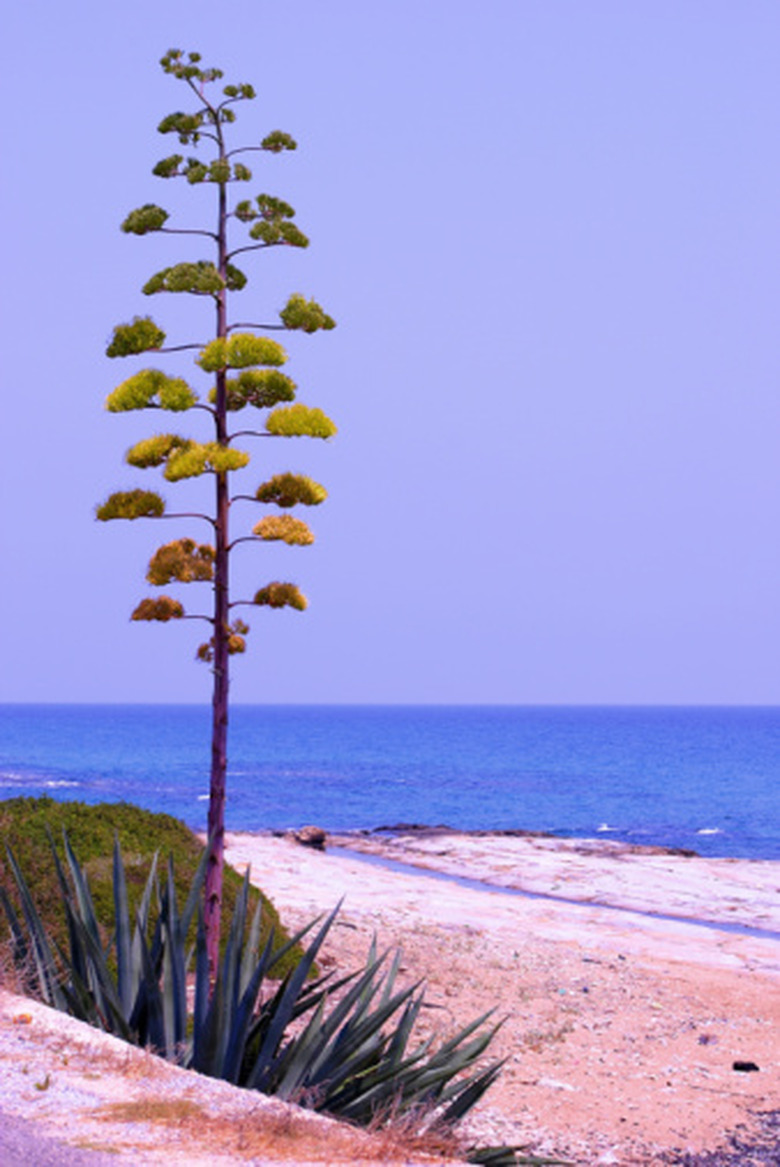Do Century Plants Die After Blooming?
The common name of century plant (Agave spp.) suggests something occurs once every 100 years. While century plants do grow slowly and take time to produce a flower spike, it blooms at 5 to 40 years of age, depending on species. As the century plant grows through the years, it produces juvenile clone plantlets at its base, creating a clumping thicket of individual plants in pointy rosette form. An individual rosette plant dies after blooming.
Types
Nearly 200 different species exist in the genus Agave, and many are commonly called century plants or agaves. These succulent plants with swordlike leaves, often with spines and sharp leaf tips, hail from arid, sunny habitats from the American Southwest and Florida into Mexico, the West Indies and northern South America. The Agave Americana produces one of the large inflorescences in the entire plant kingdom. Thousands of tiny yellow blossoms occur in a tall, branched stalk towering as high as 25 feet. The plant rosette that produces the inflorescence then dies.
- The common name of century plant (Agave spp.)
- While century plants do grow slowly and take time to produce a flower spike, it blooms at 5 to 40 years of age, depending on species.
Monocarpy
Century plants bloom once in their lifetime and then die, a botanical condition known as monocarpy. The entire plant organism does not die, just the mature leaved rosette. The oldest rosette is called the mother plant with small daughter pups or plantlets arise from the mother plant's base. The older mother reaches maturity and flowers and produces seeds. Afterward, the mother's flower stalk dries, and its leaves collapse and die. The daughter plants continue growing, perpetuating the plant colony. If no daughter plants exist, the century plant dies out.
- Century plants bloom once in their lifetime and then die, a botanical condition known as monocarpy.
- The entire plant organism does not die, just the mature leaved rosette.
Manipulating Flowering
Gardeners cannot prolong the life of an old, mature century plant by cutting the flower stalk as it emerges. Once the plant reaches maturity and initiates an inflorescence, it reached the climax in its life. The plant may not die as quickly as if it had flowered, but it will not produce another flower stalk. It still dies within 1 to 2 years, depending on growing conditions or climate.
Comparison to Yucca
Plants in the genus Yucca resemble century plants. Although both are closely related in the same plant family and are native to the Americas, flower characteristics differentiate them. Century plants are monocarpic and their flowers are rich in nectar, attracting attract insects or hummingbirds for pollination. By contrast, yuccas are polycarpic — they bloom year after year and do not die thereafter. Yucca flowers also lack nectar and are almost exclusively pollinated by moths or bats, especially at night.
- Gardeners cannot prolong the life of an old, mature century plant by cutting the flower stalk as it emerges.
- The plant may not die as quickly as if it had flowered, but it will not produce another flower stalk.
References
- "Proceedings of the National Academy of Sciences"; Timing and Rate of Speciation in Agave; Sara V. Good-Avila, et al.; June 13, 2006
- Burke's Backyard: Agave Fact Sheet
- "A-Z Encyclopedia of Garden Plants"; Christopher Brickell and H. Marc Cathey, eds.; 2004
- Flora of North America: Agave


